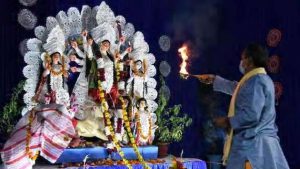OCTOBER 24, 2020

New Delhi, Oct 24 (ANI): Hindu priest performs aarti to goddess Durga during the ongoing Durga Puja festival, at Kali Mandir Monto Road in New Delhi on Saturday. (Representational) (ANI)
Dashmi, Dussehra or Vijayadashami is observed on the tenth day of the Hindu calendar month of Ashwin and marks the end of both Durga Puja and Navratri festival. This year Dashmi will fall on October 25, it is believed that it was on this day that Goddess Durga slayed the demon king Mahishasura, and another belief is that it is on this day that Lord Rama defeated King Ravana, both victories of good over evil. Hence the name Vijay Dashmi which means the day of victory. While on one hand Dashmi marks the end of two festivals it also heralds preparations for the festival of lights, which starts around (approximately) twenty days after the festival. Diwali and Celebrated with much fervour, the day symbolises the victory of good over evil when Goddess Durga killed Mahishasura, the demon king. It is also said that this was the day when Lord Rama defeated Raavan.
According to Drikpanchang, Dashmi will be celebrated on October 25 this year and the Dashami Tithi begins on 07:41 AM on Oct 25, 2020, and the ends on 09:00 AM on Oct 26, 2020.
The word Navratri translates to ‘nine nights’. In most of the parts of India different forms of the goddess, Maa Durga, are worshipped during these nine nights– Shilaputri, Brahmacharni, Chandraghanta, Kushmanda, Skandama, Katyayani, Kalratri, Maha Gauri, and Siddhidatri. On the eighth day of Navratri, devotees across the country worship Goddess Mahagauri, the eighth avatar/form of Goddess Durga. This year, COVID-19 pandemic has dampened the festivities as there is a huge decrease in the number of devotees arriving at the temple for offering prayers. Temple authorities are adhering to the COVID-19 guidelines issued by the Ministry of Home Affairs (MHA). The festival is popularly and prominently celebrated in Gujarat, Maharashtra, West Bengal and the southern state of Karnataka.
In West Bengal, the last four days of Navratri is celebrated with much pomp and enthusiasm and is known as Durga Puja. Also known as Sharad Navratri, the occasion is believed to mark Goddess Durga’s victory over demon Mahishasura, signifying the victory of good over evil. Jyoti Kalash, Kumari Puja, Sandhi Puja, Navami Homa, Lalitha Vrat and Chandi Path are other famous rituals and events which are observed during the nine days of Navratri. The 10th day of Sharad Navratri is celebrated as Dussehra or Vijaya Dashami.
Courtesy/Source: Hindustan Times / ANI










































































































